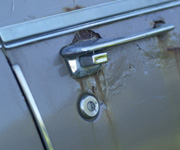| Français | Contact Us | Help | Search | Canada Site | ||||
| Home | A-Z Index | Scams/Fraud | Detachments | Publications | ||||



 |
|
| Home | |
| About the RCMP | |
| Organization | |
| Executive | |
| History | |
| Musical Ride | |
| Forms | |
| Priorities | |
| Programs and Services | |
| Newsroom | |
| Careers / Recruiting | |
RCMP Fact Sheets |
|
Paint Data Query
 |
| QUICK FACTS • The PDQ contains information on more than 13,000 vehicles, with a library of over 50,000 layers of paint. • International PDQ users include the United States, Japan, Australia, New Zealand, Singapore, and the European Union. |
Overview
The International Forensic Automotive Paint Data Query (PDQ) database is a searchable database of chemical and colour information of original automotive paints.
Developed by Forensic Laboratory Services (FLS), the database represents 30 years of accumulated information provided by automotive companies and samples of vehicles submitted by other forensic laboratories or police. The PDQ contains information about the make, model, year, and assembly plant for many vehicles.
The PDQ is used by forensic laboratories around the world to assist with criminal investigations requiring vehicle identification. FLS maintains the database so that forensic laboratories can provide timely and effective
support to police investigations. Police agencies do not access the PDQ directly.
The PDQ is one of the most collaborative ventures to be found in forensic science. Accredited users are given a free copy of the PDQ in exchange for submitting 60 new automotive paint samples per year. The paint samples are collected from vehicles at body shops or junk yards, as well as from automobile manufacturers.
Contributors to the PDQ include the RCMP, provincial forensic laboratories in Ontario and Quebec, 40 American forensic laboratories, and police agencies in 21 other countries.
How it Works
Paint samples provided by automotive manufacturers are analyzed by their chemical composition. The chemical components and proportions are coded into the database. An automotive paint job usually consists of four layers. These known paint samples are then available for comparison against paint samples taken from a crime scene or from suspect vehicles.
The PDQ team samples each paint layer with scalpels and microscopes to determine the spectra and chemical composition of the paint chips.
Once unknown vehicles are matched in the database, police can use the possible make, model and year information to search for the vehicle involved in the criminal activity, most often a hit-and-run.
The PDQ serves to narrow the search for vehicles to enable further investigation. Once a suspect vehicle is located, the comparison of paint from the crime scene with paint of the suspect vehicle can be conducted to match the vehicle more conclusively to the crime.
| Content created: 2004-11-26 Content revised: |
Return to Top | Important Notices |